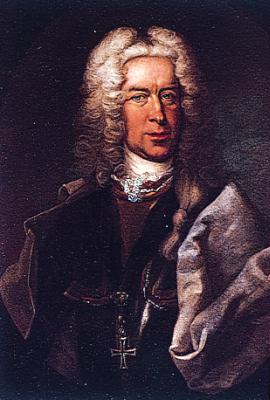Guido Starhemberg facts for kids
Quick facts for kids
Guido Starhemberg
|
|
|---|---|

Guido von Starhemberg
|
|
| Born | 11 November 1657 Graz |
| Died | 7 March 1737 (aged 79) Vienna |
| Allegiance | Austria |
| Rank | Commander-in-chief |
| Battles/wars | Great Turkish War, War of the Spanish Succession |
| Relations | Ernst Rüdiger von Starhemberg |
| Other work | Governor of Slavonia |
Guido Wald Rüdiger, Count of Starhemberg (born November 11, 1657 – died March 7, 1737) was an important Austrian military leader. He was a member of the noble House of Starhemberg family. He became a commander-in-chief, which means he was in charge of an entire army.
Contents
A Young Officer's Start
Guido Starhemberg was the cousin of Ernst Rüdiger von Starhemberg. Ernst was famous for defending Vienna during a big attack by the Turkish army in 1683. Guido worked as his cousin's assistant during this important siege.
After the siege, Guido continued to fight alongside his cousin. Later, he also served under another famous general, Prince Eugene of Savoy. They fought many battles against the Turks in what was known as the Great Turkish War.
Fighting in the War of the Spanish Succession
Guido Starhemberg played a big role in the War of the Spanish Succession. This was a major European conflict that lasted from 1701 to 1714. Countries fought over who would become the next king of Spain.
Starhemberg fought in battles in both Italy and Spain. From 1706 to 1708, he was the main commander of the Austrian army in Hungary. There, he led operations against a group of rebels led by Francis II Rákóczi. In 1708, he was made the top commander of the Austrian forces in Spain.
Capturing Madrid
In 1710, Starhemberg worked with a British general named James Stanhope. Together, they won important battles at Almenar and Saragossa. After these victories, they managed to capture the city of Madrid.
However, they faced a problem in Madrid. The people living there did not support the Habsburg prince who was supposed to become king. Because of this lack of support, Starhemberg and his troops had to leave the city in December.
Retreat and New Role
After leaving Madrid, Starhemberg's forces suffered more defeats. They lost battles at Battle of Brihuega and the Battle of Villaviciosa in 1710. These losses forced him to pull his troops back to Catalonia, a region in Spain.
When the Habsburg prince, Archduke Charles, returned to Austria, Starhemberg was given a new job. He was made the viceroy of Catalonia. A viceroy is like a governor who rules a region in the name of a king or emperor.
Later Life and Death
The War of the Spanish Succession ended with the Peace of Utrecht in 1713. After this peace treaty, Archduke Charles, who was now Emperor Charles VI, ordered Starhemberg to leave Catalonia. Starhemberg and his soldiers sailed to Genoa on English ships.
Guido Starhemberg died in 1737. At the time of his death, he was serving as the Governor of Slavonia.
See also
 In Spanish: Guido von Starhemberg para niños
In Spanish: Guido von Starhemberg para niños

